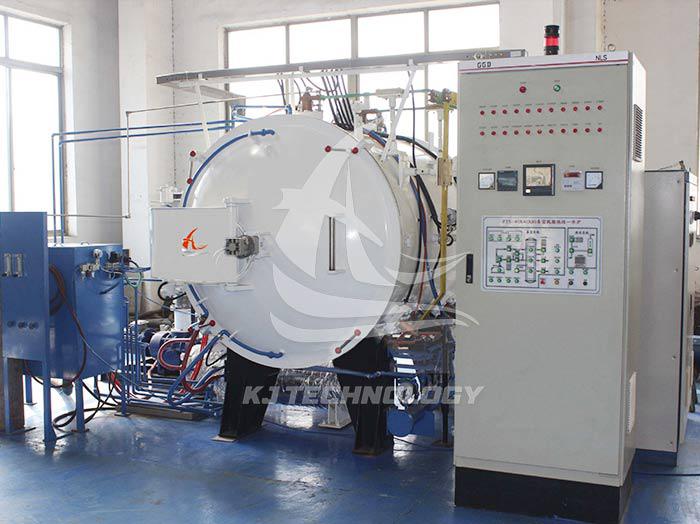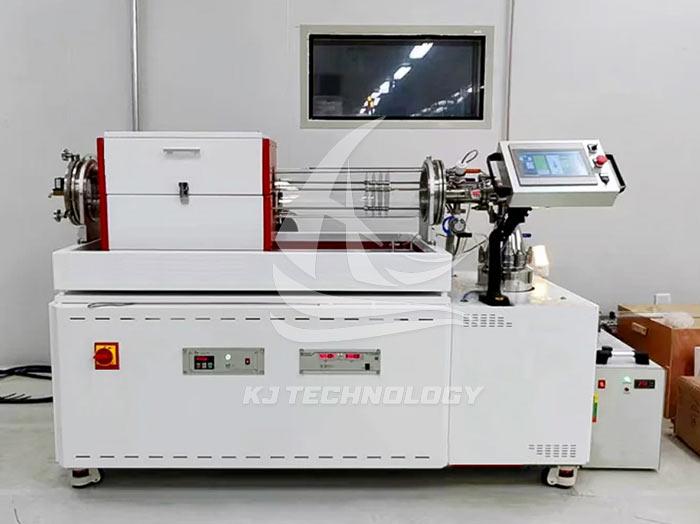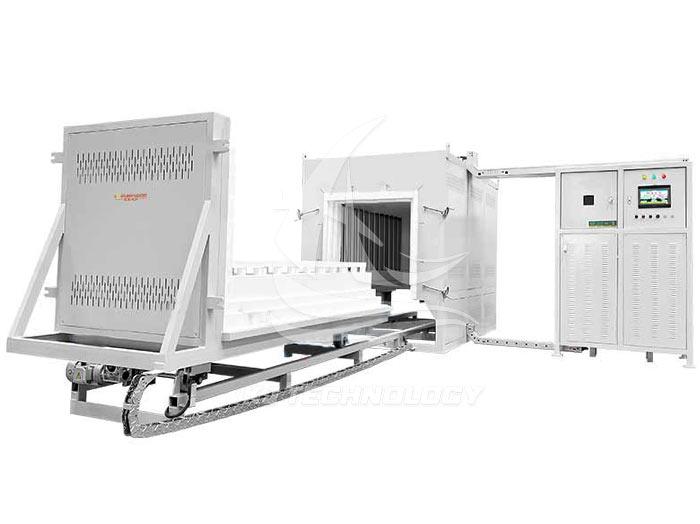Precautions for using heat treatment vacuum furnace
 09-11-2025 Author: KJ technology
09-11-2025 Author: KJ technology
As a precision heat treatment equipment, the use of heat treatment vacuum furnaces involves multiple repetitive and complex environments such as high temperature, vacuum, and electrical control. Improper operation can easily lead to equipment damage, process failure, or safety accidents. The following are the key precautions and operating specifications when using a heat treatment vacuum furnace:
1. Preparation before operation
Equipment inspection
Appearance inspection: Confirm that the furnace body, vacuum pump, cooling system, electrical control cabinet and other components are not damaged, leaking or loose.
Vacuum system inspection: Check the oil level of the vacuum pump, the oil quality is clear and free of pollution; Check whether the vacuum pipes, valves, and sealing rings are intact, without cracks or aging.
Cooling system inspection: Confirm that the cooling water flow and pressure are normal, and the inlet and outlet temperatures are normal; Check the cooling water pipeline for leaks or blockages.
Electrical system inspection: Check whether the power supply voltage and grounding wire are reliable; Confirm that the temperature control instruments, power regulators, sensors, and other electrical components are displaying normally.
Workpiece preparation
Cleaning treatment: The surface of the workpiece should be cleaned of impurities such as oil stains, rust, and oxide scales to avoid volatilization and contamination of the furnace chamber or affecting the vacuum degree during heating.
Loading capacity control: The total mass of the workpiece shall not exceed 80% of the designed capacity of the furnace chamber, and it shall be placed evenly to avoid blocking the heating element or obstructing the airflow circulation.
Fixture selection: Prioritize the use of low air release materials such as stainless steel and ceramics, and avoid the use of volatile materials such as wood and plastic.
Environmental Requirements
The area around the furnace should be kept dry, ventilated, and free of flammable and explosive materials; The ground should be flat to avoid vibration affecting equipment stability.
The temperature in the operating room should be controlled between 5-35 ℃, and the humidity should be ≤ 85% to prevent electrical components from being affected by moisture and short circuiting.
2. Operation process specification
Vacuum extraction process
Pre vacuum pumping: First, close the furnace door, start the mechanical pump to pump low vacuum to below 10Pa, and then start the Roots pump (if any) to pump high vacuum to process requirements (usually ≤ 10 ⁻ ³ Pa).
Leakage detection: Observe the change in vacuum degree during the vacuuming process. If the vacuum degree drops slowly or cannot reach the set value, stop the machine and check whether the seals, pipelines, or valves are leaking.
Baking degassing: For processes that require high vacuum, it is necessary to maintain a low temperature range (such as 200~300 ℃) for 1-2 hours to remove gases adsorbed on the furnace body and workpiece.
heating control
Heating rate: Set the heating curve according to the material characteristics to avoid deformation or cracking of the workpiece caused by rapid heating; The heating rate of general metal materials is ≤ 10 ℃/min, and that of non-metallic materials is ≤ 5 ℃/min.
Temperature uniformity: Regularly calibrate the position of thermocouples to ensure accurate temperature measurement; Observe the temperature distribution inside the furnace during the heating process and adjust the workpiece placement or heating element power if necessary.
Insulation stage: After reaching the set temperature, sufficient insulation time is required to ensure uniform transformation of the internal structure of the workpiece; During the insulation period, closely monitor temperature fluctuations (usually ≤± 5 ℃).
cooling control
Cooling method selection: Choose gas cooling (filled with inert gases such as nitrogen or argon) or oil cooling according to process requirements; During air cooling, it is necessary to control the inflation rate to avoid cracking of the workpiece due to thermal stress.
Cooling rate control: The cooling rate should match the hardenability of the material to avoid cracking caused by too fast or coarsening caused by too slow; The cooling rate of general steel parts is ≥ 50 ℃/s, and that of non-ferrous metals is ≤ 20 ℃/s.
Cooling endpoint determination: Confirm that the temperature of the workpiece has dropped to a safe range (usually ≤ 100 ℃) through a thermometer or infrared thermometer before starting the furnace to take out the workpiece.
3. Safety protection measures
personal protection
Operators need to wear protective goggles, insulated gloves, dust masks and other protective equipment to avoid high temperature burns, dust inhalation or radiation injuries.
Do not wear synthetic clothing during operation to prevent sparks caused by static electricity.
Equipment safety
Overtemperature protection: Set dual overtemperature alarms (such as instrument alarm+independent temperature relay), and automatically cut off the heating power when the temperature exceeds the set value of 5-10 ℃.
Overpressure protection: Install a pressure relief valve that automatically releases pressure when the furnace pressure exceeds the safety limit (usually ≤ 0.1MPa).
Emergency stop device: Install emergency stop buttons near the control cabinet and furnace body to immediately cut off all power and gas sources in case of emergency.
emergency response
Vacuum leakage: Immediately turn off the vacuum pump, stop heating, open the furnace door for ventilation, identify and repair the leakage point, and then re evacuate.
Cooling water failure: If the cooling water is interrupted, stop heating and shut down the equipment within 5 minutes, and restart after the cooling water is restored.
Electrical fire: immediately cut off the power supply, use dry powder extinguisher to extinguish the fire, and prohibit using water or foam extinguisher.
4. Maintenance and upkeep
routine maintenance
Cleaning the furnace chamber: Use a vacuum cleaner or soft cloth to clean the residue inside the furnace after each use to avoid contaminating the next process.
Check seals: Regularly inspect the sealing rings at furnace doors, observation windows, and pipeline connections, and replace aging or damaged parts in a timely manner.
Lubricate moving parts: Regularly apply high-temperature grease to furnace door guide rails, vacuum pump bearings, and other parts to reduce wear.
regular maintenance
Vacuum pump maintenance: Replace the vacuum pump oil and clean the oil filter every 500 hours of operation; Inspect vulnerable parts such as the impeller and shaft seal of the vacuum pump every 2000 hours.
Heating element detection: Measure the resistance value of the heating element every six months, and replace it if the deviation exceeds ± 10%.
Temperature control system calibration: Every year, a professional organization is commissioned to calibrate temperature control instruments and thermocouples to ensure temperature measurement accuracy of ≤± 1 ℃.
Long term disuse maintenance
Evacuate the residual gas in the furnace and fill it with dry nitrogen for protection; Close the cooling water main valve and drain the accumulated water in the pipeline.
Cut off the power and place desiccants in the electrical control cabinet to prevent moisture and short circuits.
5. Operation taboos
Prohibited live operation: During the operation of the equipment, it is strictly prohibited to open the furnace door or touch live parts.
Overloading operation is prohibited: the total mass or size of the workpiece must not exceed the design limit of the furnace cavity to avoid damaging the heating element or furnace structure.
Prohibition of unauthorized inflation: Oxygen or flammable gases must not be filled before reaching the safe temperature to prevent explosions or fires.
Unauthorized operation is prohibited: Non professionals are not allowed to adjust equipment parameters or disassemble and repair them without authorization. They must be operated by trained and qualified personnel.








